🎺 From Microphones to Setup & Processing — Learn How to Record Your Trumpet or Brass Instrument the Right Way!
As a professional brass player, achieving a high-quality recording of your trumpet from a home studio is not only possible—it’s increasingly essential. Whether you’re submitting auditions, producing session work, or creating content for social media and streaming platforms, capturing your best sound requires the right tools and a thoughtful approach.
Recording trumpet at a professional level demands three core elements: the right microphone, proper mic placement, and smart processing techniques. You want a recording that captures the full dynamic range, warmth, and brilliance of your instrument—without harshness or unwanted room reflections.
Based on my own experimentation, the recommendations of professional audio engineers, and the techniques I’ve developed while recording my albums, I’ve compiled this guide to share what works. It outlines three top microphone options across different budgets, along with best practices for mic positioning, DAW setup, and whether to record with or without effects.
Topics Covered in This Guide:
- The 3 best microphones for trumpet (budget, mid-level, pro)
- Optimal microphone placement for the best sound
- DAW input settings & recording tips
- Should you process while recording or keep it dry?
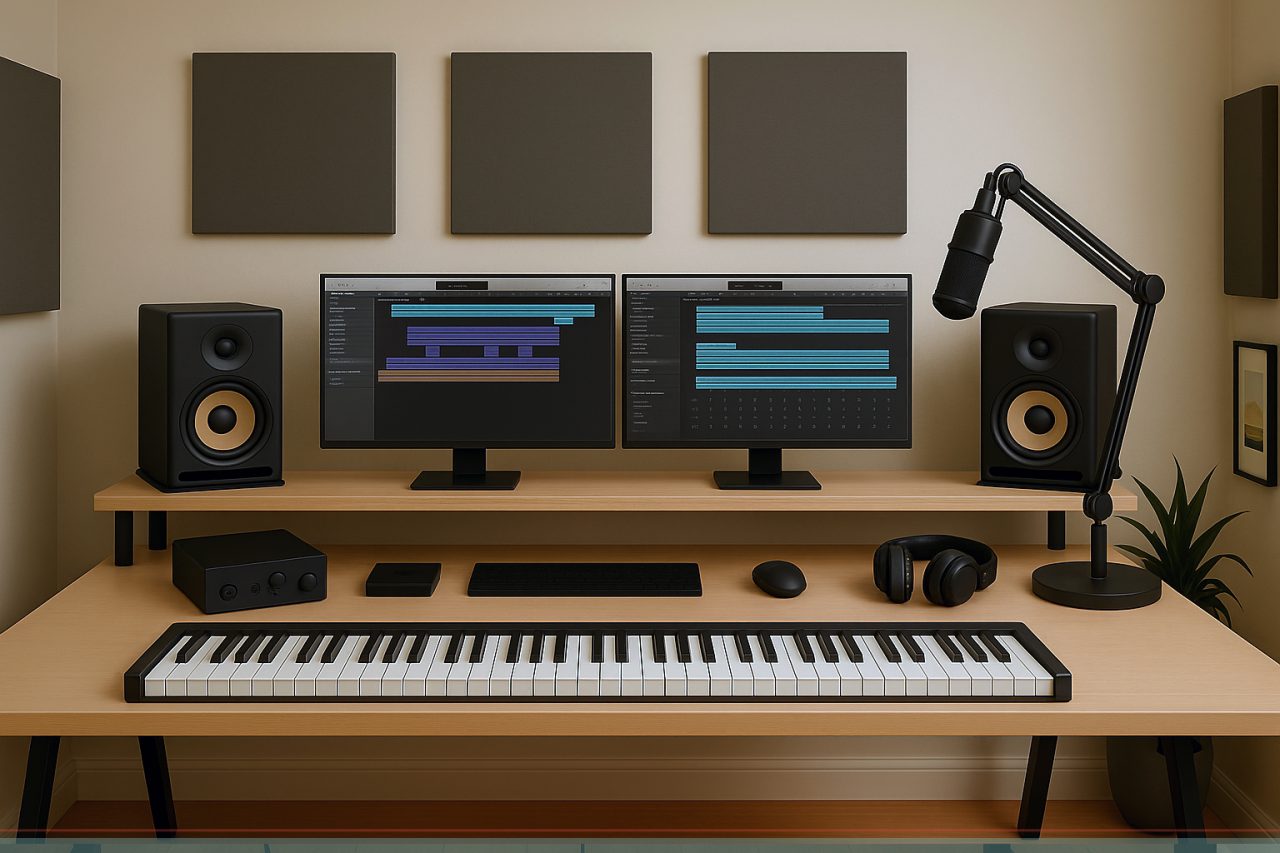
🎙️ Best Microphones for Recording Trumpet at Home
1. Entry-Level: Audio-Technica AT2020 (Condenser Mic) — Approx. $100![]() The AT2020 is a budget-friendly large-diaphragm condenser mic that delivers impressive clarity and detail for its price point. While it lacks some of the richness of high-end models, it handles the trumpet’s brightness and dynamic range well—especially with good placement.
The AT2020 is a budget-friendly large-diaphragm condenser mic that delivers impressive clarity and detail for its price point. While it lacks some of the richness of high-end models, it handles the trumpet’s brightness and dynamic range well—especially with good placement.
Best for: Emerging players, auditions, practice recordings, and budget-conscious pros.
2. Mid-Level: Sennheiser MD 421 II (Dynamic Mic) — Approx. $430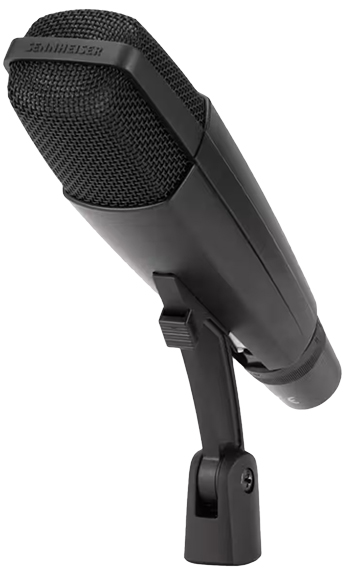 This broadcast-quality dynamic mic is a studio workhorse, known for its smooth high-end response and ability to withstand high SPLs. It captures trumpet with presence and control, making it ideal for more serious production without overwhelming your budget.
This broadcast-quality dynamic mic is a studio workhorse, known for its smooth high-end response and ability to withstand high SPLs. It captures trumpet with presence and control, making it ideal for more serious production without overwhelming your budget.
Best for: Professional demos, remote session work, and commercial production.
3. Pro-Level: Royer R-121 (Ribbon Mic) — Approx. $1,300![]() The Royer R-121 is a top-tier ribbon microphone that excels with brass instruments. It smooths out upper-frequency harshness, offering a warm, natural, and authentic sound. Its figure-8 pattern helps reject room reflections from the sides, a plus for untreated spaces. Use with a high-gain, low-noise preamp or an inline booster like a Cloudlifter.
The Royer R-121 is a top-tier ribbon microphone that excels with brass instruments. It smooths out upper-frequency harshness, offering a warm, natural, and authentic sound. Its figure-8 pattern helps reject room reflections from the sides, a plus for untreated spaces. Use with a high-gain, low-noise preamp or an inline booster like a Cloudlifter.
Best for: Final album projects, commercial-quality production, and solo work where tonal nuance is critical.
🎯 Microphone Placement for Trumpet
Proper mic placement can make a bigger impact than the mic itself. Here’s a go-to setup for solo trumpet:
Distance: Start at 2 to 4 feet from the bell. Closer gives more presence and articulation; farther offers a more natural sound. Too close, and you risk distortion, breath noise, or exaggerated transients.
Angle: Avoid pointing directly into the bell. Angle the mic 15–30 degrees off-axis to tame harshness and capture a more balanced tone.
Height: Mic level with the bell’s rim yields a neutral tone. Slightly above captures brightness; slightly below adds warmth.
Room Considerations: Record in the most acoustically controlled space you can. If untreated, hang thick blankets or use portable panels behind and around the mic to minimize reflections and slapback.
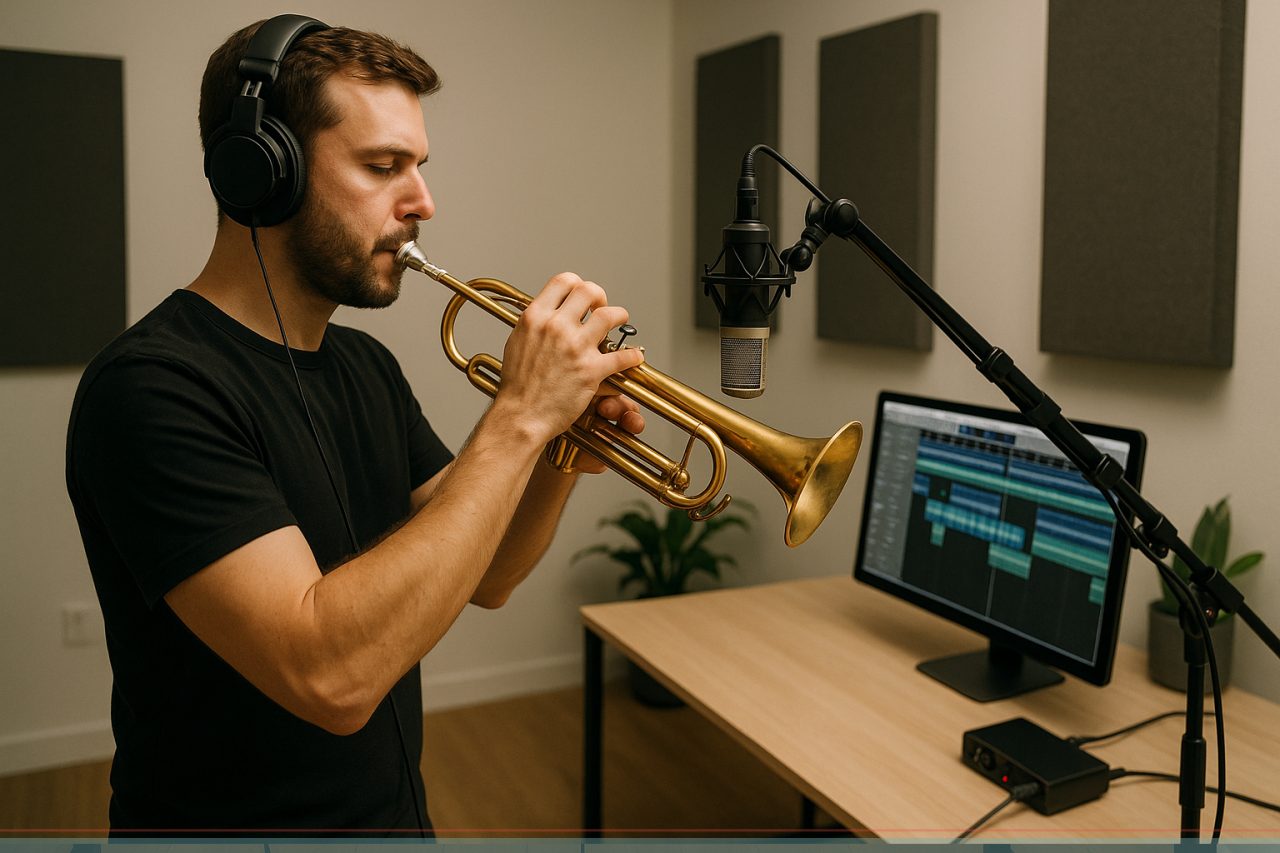
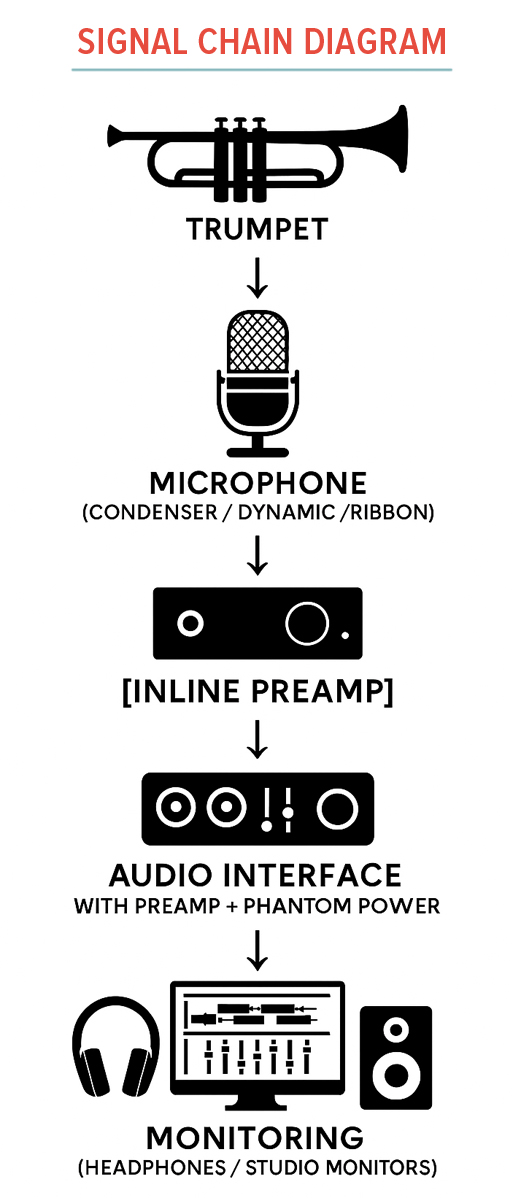 🖥️ DAW Input Setup & Signal Chain
🖥️ DAW Input Setup & Signal Chain
Regardless of your DAW (Logic Pro, Pro Tools, Reaper, Cubase, etc.), the principles of input setup remain consistent:
Mic to Interface: Connect your mic to an audio interface with 48V phantom power for condenser mics (and some ribbons if specified). For the R-121, consider using an inline preamp like a Cloudlifter. A high-quality interface like the Apogee Duet offers ultra-clean preamps, excellent A/D conversion, and low-latency performance—ideal for capturing the nuance of brass instruments.
Gain Staging: Set input gain so that your loudest playing peaks around -6 dBFS. This preserves headroom and avoids clipping.
Sample Rate & Bit Depth: Record at 48kHz / 24-bit for professional results and future-proofing.
Low Latency Monitoring: Use direct monitoring through your interface if available to reduce delay while playing.
💡 Tip: If your interface includes DSP (like Universal Audio), consider using clean monitoring reverb during tracking—but keep it off the recorded signal.
🎛️ Recording Dry vs. Using Plugins
Record Dry: Always record trumpet dry—no EQ, compression, or reverb printed to track. This gives you full control in post-production and avoids committing to effects that may not suit the final mix. Monitor with Light Reverb: For a more inspiring experience while tracking, use a light reverb on a monitoring bus only. This mimics a natural performance environment without affecting the recorded audio.
🔌 Gear Highlight: Apogee Duet
The Apogee Duet is a premium 2-channel audio interface that delivers pristine conversion and world-class mic preamps. Its compact design, low noise floor, and smooth gain structure make it an excellent choice for trumpet players seeking broadcast-quality sound from home. Compatible with macOS and iOS, it’s ideal for mobile or desktop studio setups.
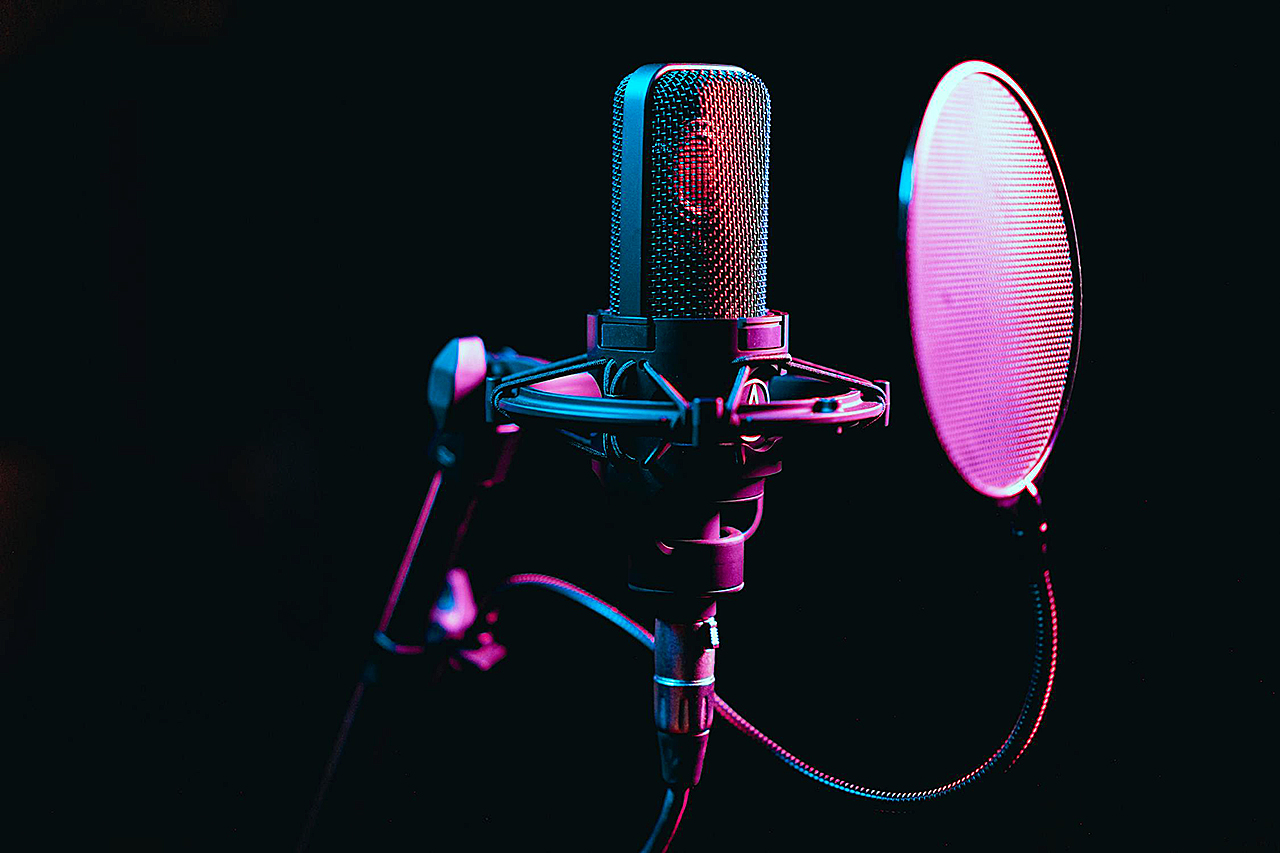
🔧 Post-Production Enhancements
After recording, use subtle processing to enhance your sound without compromising the trumpet’s character:
EQ: Apply a high-pass filter at 80–100 Hz to clean up low-end rumble. Gently reduce 2–4 kHz if there’s harshness, and optionally boost 8–10 kHz for added air and sparkle.
Compression: Apply light compression (e.g., 2:1 ratio, 3–5 dB of gain reduction) to smooth peaks. Avoid over-compression that flattens dynamics.
Reverb: Add tasteful room, hall, or plate reverb based on the musical context. Brass often shines with natural-sounding space.
De-essing: If needed, use a light de-esser to tame hiss or excessive brightness in the upper mids.
Phase Alignment: If using both a close and room mic, align phase manually in your DAW to avoid comb filtering and loss of tone.
🧠 Final Thoughts
With the right approach, professional-sounding trumpet recordings from home are absolutely achievable. Prioritize mic placement, clean signal capture, and controlled post-processing. Even entry-level setups can produce excellent results when used with care.
🎧 Audio Interface Tip: For ribbon mics (or any low-output mic), use an interface with high-quality preamps and clean gain. Top choices include the Apogee Duet, Universal Audio Apollo, and Focusrite Clarett. These interfaces deliver low noise, accurate conversion, and plenty of headroom—essential for capturing the full nuance of the trumpet. Avoid budget interfaces with noisy or underpowered gain stages that can degrade your signal quality.
Pro tip: Always trust your ears. Record short takes with different placements and compare them critically. The trumpet is a powerful, expressive instrument—your recording setup should be a partner in helping it speak clearly and beautifully.
🔑 Key takeaways:
✔ Mic placement is crucial—avoid pointing directly into the bell.
✔ Record dry and process later for maximum flexibility.
✔ Treat your room or get closer to the mic to reduce unwanted reflections.
Now, go capture that perfect trumpet sound! 🎺🎶
BONUS SECTION
🎙️ Mic Types Explained: Condenser vs. Dynamic vs. Ribbon
-
Condenser Microphones
Sensitive and accurate, condenser mics are great at capturing detail and nuance. They require phantom power (48V) and are ideal for studio environments. For trumpet, they capture clarity and brightness but can be harsh if placed too close or aimed directly at the bell. -
Dynamic Microphones
Durable and less sensitive, dynamic mics handle high sound pressure levels (SPLs) well, making them great for loud sources like brass. They’re more forgiving in untreated rooms but have a narrower frequency response compared to condensers. -
Ribbon Microphones
Known for their warm, natural sound, ribbon mics smooth out the high end—perfect for taming trumpet brightness. They use a delicate thin ribbon to capture sound and often need a lot of clean gain or a preamp booster (like a Cloudlifter). Handle with care—they’re fragile and can be damaged by phantom power if not properly protected.
